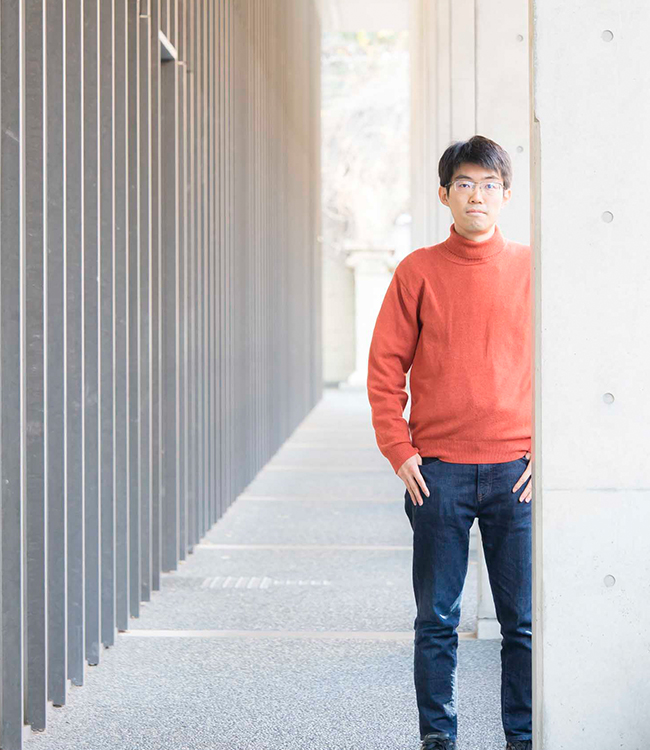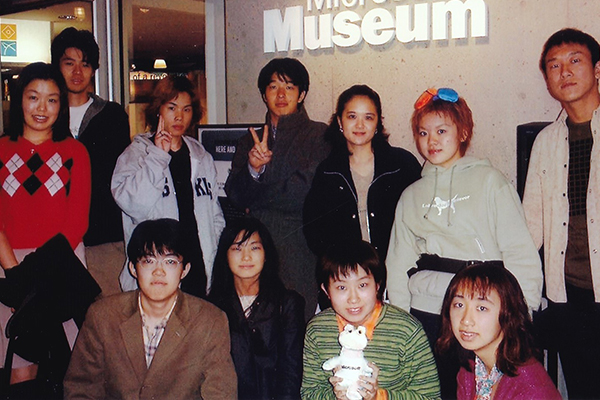Takuo Sugaya
Associate Professor, Stanford University
Class of 2007, Master’s degree, Graduate School of Economics
(Recipient of a President’s Award in AY 2004)
https://www.gsb.stanford.edu/faculty-research/faculty/takuo-sugaya
Associate Professor, Stanford University
Class of 2007, Master’s degree, Graduate School of Economics
(Recipient of a President’s Award in AY 2004)
https://www.gsb.stanford.edu/faculty-research/faculty/takuo-sugaya

Mr. Sugaya was admitted to the University of Tokyo’s Graduate School of Economics after studying in the Senior Division of the University’s College of Arts and Sciences. He went on to obtain his PhD at Princeton University, and is currently conducting education and research activities as an associate professor at Stanford University’s Graduate School of Business. He specializes in game theory, which is a well-known field of microeconomics.
“To give an example,” explains Mr. Sugaya, “companies in the same industry sometimes collude to raise prices. I have recently been looking into the conditions which determined whether companies would succeed or fail in the vitamin price-fixing cases that we saw in the 1990s. By using mathematical models, I am analyzing the kinds of cooperative behaviors taken under such conditions by companies based on their long-term relationships with each other.”
In his educational activities, he supervises three or four doctoral students as they write their papers while also teaching microeconomics classes to about 50 students enrolled in the master’s course. In their evaluation of past classes, some students pointed out that Mr. Sugaya’s English was difficult to understand, so he now rehearses each of his classes at least once. Why did he leave Japan to go overseas, despite the language barrier?
“Because the world of game theory research revolves around the three main hubs of Princeton, Yale and Stanford. Also, almost all my graduate school teachers and colleagues at the University of Tokyo had spent time studying in the United States, and being in this environment naturally made me want to go and study there, too.”
“To give an example,” explains Mr. Sugaya, “companies in the same industry sometimes collude to raise prices. I have recently been looking into the conditions which determined whether companies would succeed or fail in the vitamin price-fixing cases that we saw in the 1990s. By using mathematical models, I am analyzing the kinds of cooperative behaviors taken under such conditions by companies based on their long-term relationships with each other.”
In his educational activities, he supervises three or four doctoral students as they write their papers while also teaching microeconomics classes to about 50 students enrolled in the master’s course. In their evaluation of past classes, some students pointed out that Mr. Sugaya’s English was difficult to understand, so he now rehearses each of his classes at least once. Why did he leave Japan to go overseas, despite the language barrier?
“Because the world of game theory research revolves around the three main hubs of Princeton, Yale and Stanford. Also, almost all my graduate school teachers and colleagues at the University of Tokyo had spent time studying in the United States, and being in this environment naturally made me want to go and study there, too.”

Although it is said that the University of Tokyo tends not to be well known in the West, this is not the case in economics. At Stanford University in particular, graduates of the University of Tokyo have a history of showcasing their talents in the field of theoretical economics, and Mr. Sugaya is one of the latest UTokyo graduates to add his name to this esteemed list of scholars. Last year, he married a woman from New York with whom he had studied economics at Princeton University. His marriage, occurring 10 years after he left Japan, has made him even more motivated to continue his research. Is returning to teach at a Japanese university an option for him in the future?
“My wife has no Japanese language ability, so it would be difficult for us to move to Japan. Besides, in two years, I will take an examination for a tenure-track position, and my future depends on the result.”
If the University of Tokyo wants to deepen its “cooperative behavior” with Mr. Sugaya, it has two years to provide an environment where even those who cannot speak Japanese can be comfortable on campus.
“My wife has no Japanese language ability, so it would be difficult for us to move to Japan. Besides, in two years, I will take an examination for a tenure-track position, and my future depends on the result.”
If the University of Tokyo wants to deepen its “cooperative behavior” with Mr. Sugaya, it has two years to provide an environment where even those who cannot speak Japanese can be comfortable on campus.
Q&A Extras
What student group(s) did you participate in when you were at UTokyo?
“I was a member of the Philomusica Symphony Orchestra. I was the deputy head of the orchestra when I was a sophomore.”
Could you comment on the viola, the instrument you played in the Orchestra?
“It suits me in that it’s not as flashy as the violin.”
Did you have any favorite places on the University of Tokyo campuses?
“The room for graduate students located in the Akamon General Research Building in Hongo and the Campus Plaza in Komaba.”What do you think differentiates the University of Tokyo from American universities?
“In terms of the quality of students, I feel that American universities have large upper and lower groups while the University of Tokyo has a large middle group.”
Note: This article was originally printed in Tansei 34 (Japanese language only). All information in this article is as of March 2017.






